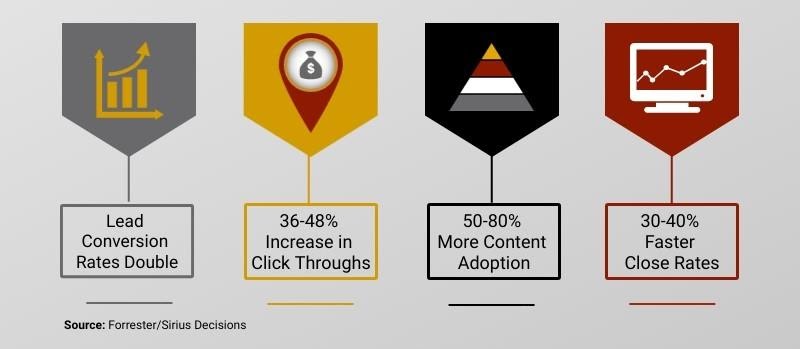We are shocked to hear anyone say that buyer personas are fictional. Why would anyone rely on fiction for important decisions?
And although simple approaches are always appealing, please be clear that there is no ROI when you download buyer persona templates from the Internet and fill in the blanks. Templates only organize your existing perceptions, or even more dangerously, your company’s assumptions and wishful thinking.
The ROI on buyer personas is impressive and measurable … when they convey the whole truth about what your prospective customers need to know and experience before they make a buying decision, and when you commit to giving your buyer personas what they want.
Understand your customers’ needs throughout their buying journey
Motivated by the goal to build empathy for their customers, companies can spend significant sums on buyer profiles that depict their persona’s personality, professional goals, business problems, or “a day in the life” of a person in that role.
This “people profile” approach to buyer personas usually works well when the customer’s buying journey is short and uncomplicated.
But for B2B companies or complex B2C decisions, people profiles should be the cover sheet for a buyer persona describing your buyer’s questions, concerns and decision criteria when they are evaluating the purchase you want them to prioritize. These buyers probably haven’t purchased anything like yours for years and a lot has changed. Already coping with a full plate of responsibilities, this buyer is confronted with an evaluation that will require a significant effort over weeks, months, or even years. Most critically, this persona knows that their choice of providers will have long-term consequences for them, their teams and their company.
A recent study by Salesforce underlines the ROI of knowing your buyer’s decision mindset, with 81% of B2B buyers choosing the company that provides the best buying experience, 45% stating that most companies don’t meet their needs during their evaluation, and 50% who stopped buying from a current provider because a competitor provided a better buying experience.
When your teams understand your customer’s needs at every step in their buying journey, you can be the provider who makes it easy for buyers to choose you.
Buyers reveal what they want at each step in their journey
Your customer knowledge probably originates with your executives and salespeople, plus interactions with your most referenceable customers.
If this is you, please notice that you are working in an echo chamber. Your best customers achieved that status because they perceive a close match between your story and their needs. These personas will do nothing to inform your actions to win a market full of prospects.
Data acquired from your salespeople is even more concerning. First, your reps are exposed to only a small part of your customer’s overall journey. Worse yet, prospects over emphasize cost with your salespeople to help them negotiate the best possible price. The simple truth is that B2B buyers almost never choose the lowest cost solution and that your reps’ knowledge is biased by their goal to close the deal.
To achieve an ROI on your buyer persona initiative, you need to invest in one-on-one interviews with people who have recently considered the product, service or solution you want them to prioritize. This isn’t traditional research involving surveys or focus groups. A skilled interviewer needs to think like a journalist, working without a script and walking each buyer very slowly through every step in their actual journey. The most critical skill is asking follow-up questions to probe on every response, which is where you’ll gain deep insights into the buyer’s motivations, objections and decision criteria.
If you are entering a new market or have an entirely new solution, you will need interviews with people who have recently spent money to solve the same problem. Insight into those customer’s decisions will clarify the attitudes and processes you will need to interrupt so you can be heard.
No more fiction! Mine the buyer’s true stories for patterns
Personas must be built from real buyer interviews to ensure their authenticity and objectivity. Ideal customer profiles can be too one-sided, personas must aggregate the true experiences related by people who compared all of their options and chose you, your competitors, or the status quo.
To build an authentic buyer persona that easily conveys the emotional and practical aspects of your persona’s buying decision, the interview transcripts need to be mined for verbatim quotes and analyzed for patterns in each of the following categories:
Priority Initiative: What triggers your persona’s decision to make this type of investment their top priority?
Success Factors: How does your persona describe the results they need to achieve by making this investment?
Perceived Barriers: What prevents buyers from moving forward with this purchase and why they might prefer another provider
Decision Criteria: Questions your personas ask about each provider’s company and solution as they compare their options
Buyer’s Journey: Which personas and resources factor into the buyer’s choices at each step in their journey
When companies are confused about how many buyer personas they need, it’s because they are thinking about “people profiles” with attributes such as job title, company size, industry/vertical market or geography. Teams struggle to take action on so many people profiles and may even produce a negative ROI, investing in activities that do nothing to improve the customer’s buying experience.
Any confusion around the number of buyer personas disappears when they are defined by their buying experiences. An analysis of the buyer interviews makes it easy to see if certain types of buyers need specialized information before they can commit to this type of purchase. Patterns will emerge in the form of distinct persona questions, barriers or priorities.
You will want more than one buyer persona only when they clarify the need for your team to invest in unique efforts to engage those audiences.
Buyer personas are an agent of change
To see a measurable ROI on buyer personas, it’s not enough to build great insights and publish your results. Your teams must have the confidence to change the way they engage with those buyers.
You have solved the first barrier to ensuring confidence in your personas when you avoid fiction and invest in real buyer interviews. Now you can credibly state that these personas reflect the attitudes and journeys of real buyers who have recently considered buying a solution like yours. These are the people you wanted to have in your pipeline and would have wanted as customers.
Specificity is the next barrier to your team’s confidence in making changes. Fortunately, you aren’t asking anyone to empathize with the buyer’s persona and imagine how they might adjust their actions. The patterns across all five categories of buying insights will explain where your approach to buyer engagement deserves continued investment and more critically, what you need to do and say to fill the gaps in the customer’s buying experience.
The final hurdle for activating your buyer personas is your team’s motivation to change. Before this pandemic and economic crisis, we encouraged marketers to implement personas when their company wasn’t satisfied that their current approach would achieve a specific goal. Some were focused on an upcoming launch, a shift in the type of buyers who were making decisions, or market segments where the company was experiencing significant competitive threats.
It’s likely that many of your stakeholders now lack confidence that most of your business-as-usual strategies will work. Thus, this may be your ideal moment to implement a buyer persona initiative, just don’t forget to consider your team’s willingness to engage in next steps once the personas are complete. You will need to ensure that someone among your internal stakeholders is ready to make the changes that will improve your customer’s buying experience.
What needs to change when you activate personas for high ROI
It’s rare to find a time when your company will be prepared to make widespread changes across sales, marketing and product efforts. So we generally recommend that persona activation begin with small steps to prove the results that can be achieved, and then you can use that success to extend the momentum to benefit as many parts of the customer’s buying experience as possible.
Briefly, here are a few places where you can quickly prove a measurable return on your investment in buyer personas.
Messaging: The fastest route to ROI on buyer personas is often achieved by adjusting your marketing messages and sales enablement tools. For example, you will likely learn that your prospective customer’s goals are a good match for your existing benefits messaging. But few companies have developed the messages and tools to explain how and why they are best qualified to deliver those benefits.
Sales enablement: Across 81% of our studies, buyers say that they eliminate providers from consideration when their salespeople don’t understand their needs or answer their questions. Through the verbatim quotes and decision criteria insights in your buyer persona, you will hear the questions your buyers are asking and even the answers they are seeking. This is an opportunity to upgrade your sales playbooks and content to prepare for your salespeople to be helpful to buyers. Your salespeople will also quickly identify the buyers who will never choose you, so they can stop wasting time on deals they can’t win.
Digital channels: You may see that you have the right content but it is too hard for buyers to find – it is either buried on your website, or maybe your buyers rarely visit your website. If another channel is a preferred resource for your buyers, you can adjust accordingly.
Events: Reviewing your plans for an upcoming virtual event, you will want to see if your speakers are prepared to address the most critical issues your research has uncovered, and if the invitations to the event are optimized by focusing on your buyer’s most urgent needs.
Product Roadmap: You may be surprised to learn that product teams can also be a source of ROI on buyer personas, revealing the subset of capabilities that are crucial to the customer’s choice of providers. Even the best customer experience teams can miss these details, especially when the capability is extremely valuable for the economic buyer but relatively less important to users.
The more you invest in buyer personas, the greater the ROI
The ROI on buyer personas begins when your teams can “walk in the persona’s shoes” during their crucial journey to evaluate the investment you want them to prioritize. Then your teams must make it easy for those personas to find the knowledge and experiences that earn their trust, and their business.
When you make this investment, you will improve metrics across every part of marketing, including demand generation, lead nurturing and conversion rates. Sales teams will see faster close times and improve their ability to forecast sales results. Product teams will understand how their roadmap affects buying decisions.
We’ve emphasized these aspects of ROI because they are measurable and will help you to justify the investments we’ve discussed.
We would be remiss to end this discussion, however, without also acknowledging the cultural impact when you use authentic buyer personas to bring diverse stakeholders together for a unique conversation. Many clients tell us that they cannot recall another time when product, sales and marketing leadership have met to objectively review the intersection between the prospective customer’s needs and their own strategies. For the first time, everyone can see how their diverse efforts must work together to impress future customers, and which changes will measurably impact their company’s growth.
To speak to a buyer persona expert or download our free resources, visit us at www.buyerpersona.com.





